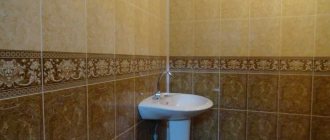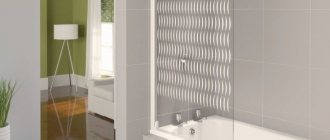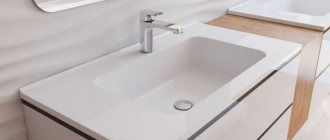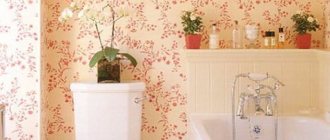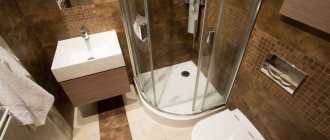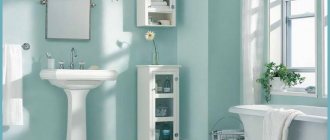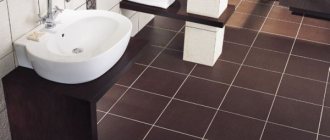The bathroom is one of the most difficult rooms to use. In addition to high humidity, certain inconveniences for others are created by the strong echo and peculiar noise created by pouring water while taking a shower or by the housewife while doing laundry. Soundproofing the walls in the bathroom will help solve the problem. But not everything is as simple as it seems at first glance. The fact is that when installing insulation in a bathroom, it is necessary to take into account some nuances related to the characteristics of the microclimate present in the room.
Soundproofing a bathroom wall
The bathroom is a place where you can take a break from the bustle of the city, relax, think, take an aroma bath and be in silence. But how can you do this if water is pouring down the riser from above, the elevator doors opened on the side, and someone broke a glass from below. Soundproofing the wall in the bathroom is desirable for your own comfort and coziness. Materials are used that do not rot under constant exposure to moisture. Installation is carried out according to the instructions created by the craftsmen.
Noise Removal
Before eliminating noise, it is necessary to determine its cause. If noise causes resonance of the collector or impacts of the collector on the ceiling, it is enough to install 1-2 additional fasteners on the pipe. If the noise is caused by the thin walls of a plastic pipe, it is necessary to wrap them with soundproofing material, cover them with a soundproofing panel, and install thick-walled plastic or cast iron pipes.
To eliminate noise from excessive (improper) ventilation, contact the management company. Serious intervention in the sewer system will be required, so specialists must work.
Sewer pipe fastening with sound insulation
Soundproofing problem in the bathroom
When purchasing an apartment, owners pay attention to the shortcomings, including sound insulation. These are not only loud, audible sounds from the street, landing, or neighbors’ apartment. But also audibility in the bathroom. This may come to light later, while taking a bath, or while relaxing, you can hear a child playing a computer game or a neighbor watching TV. You can often hear the noise of a descending elevator, the voices of animals, or water draining from neighbors above.
This does not allow you to comfortably take a bath or relax after a working day. Drain pipes are often not insulated (even in new houses). At night you can hear the sound of water draining or the sound of a cast iron bathtub filling.
To carry out the soundproofing process, you need materials, tools and knowledge of the stages of work. Properly done sound insulation will eliminate annoying sounds at night and bring comfort and peace of mind.
Types of noise and causes of their occurrence
In modern sewer “acoustics” there may be various sources of noise and the reasons for their occurrence.
The most common are:
- noise of resonant origin. The sounds are based on the phenomenon of resonance, where the plastic pipes themselves act as a resonator;
- atmospheric sounds. They occur during the penetration of air currents into the drain pipes, which are discharged onto the roof;
- vibration noises. Their occurrence is associated with the specifics of the construction of a sewer system, in which each part sounds the same as the whole pipeline. Not only risers vibrate, but also elbows, couplings, joints, and fastening clamps;
- impact type noises. They are among the loudest and most unpleasant. Anything that enters the sewer system falls from a certain height, causing a loud sound. Such a sewer vertical can be compared to a resonant-oscillating system.
Materials
The construction market has a large selection of materials that create sound insulation and insulation. But, to carry out such procedures, you need materials suitable for rooms with high humidity.
- Mineral (basalt) wool. Does not disintegrate when exposed to moisture. It also doesn't burn. It has the properties of muffling noise and insulating the room. To use cotton wool, you need to choose the right waterproofing material.
- Polymer membrane. This is a rolled material, up to 4 mm thick. On one side it is sticky, which makes installation easier. When using a membrane, you should take care of the material that will cover it.
- Noise-absorbing panel. Has a mineral filler. Moisture-resistant, vapor-permeable, which is an important factor. It's easy to install. After installation, the seams of the panels are sealed with tape.
- Application of soundproofing plaster PalaplasteR-207. It is applied in a layer of 3 cm. It is cement based and is moisture resistant.
Before using the material, you must carefully study the technical specifications.
Under tiles
Tiles in the bathroom are laid on the walls and floor.
To soundproof the walls, use basalt wool no thicker than 5 mm and a water barrier. They create a metal frame for moisture-resistant plasterboard sheets. After this, the joints are reinforced, the gypsum boards are puttied and primed. A membrane and noise-absorbing panels are laid on the floor. After this, a screed is made and the tiles are laid.
On the walls
Rolled waterproofing material or bitumen-based mixtures are suitable for walls. Soundproofing material should not rot from moisture. Green Knauf plasterboard sheets.
If you choose sound-absorbing panels, the joints should be carefully sealed with tape and joint putty.
Cement-based soundproofing plaster does not absorb moisture. Before application, the walls must be treated with a bitumen-based mixture.
Ready-made ZIPS tongue-and-groove panels. It is a combination of gypsum fiber sheets and staple fiberglass.
To the ceiling
A metal frame is created for the ceiling, into which soundproofing material is placed.
This is mineral wool. And also a way out of a noisy situation would be to create a suspended acoustic ceiling.
For it, slabs made of thin fiberglass and mineral fiber are chosen.
The metal frame for the ceiling is created using vibration suspensions and damper tape.
On the floor
When performing soundproofing of the floor, it is necessary to select a waterproofing material. Mostly solutions of bitumen and polymers are chosen. After treatment with bitumen, a membrane is laid. The joints must be glued together with adhesive tape.
For the floor, fiberglass "Shumanet-100" 3 mm, as well as "Shumanet-P60" - 20 mm, are used. foam propylene, cork agglomerate, and silica fiber are also laid. After this, make a 6 cm screed and lay tiles or create a “warm floor”.
Clamps with rubber inserts and damping pads
This method of dealing with excess noise is based on reducing the level of pipe vibration associated with the beating of the flow against the walls. Due to the fact that the clamps are equipped with internal ring inserts made of dense but elastic rubber, the pipe maintains a stable position, vibrations are damped and are not transmitted (or transmitted to a lesser extent) to building structures.
The video shows a simple method of installing a riser using clamps with damping inserts. Also, such inserts are convenient for isolating the riser where it passes through the wall and/or ceiling of the building (photo below).
When using the last option, a hole is cut in the building structure with a diameter that corresponds to the diameter of the pipe, taking into account the damping insert. The pipe should pass through the hole with little effort, “with interference.” If the riser must pass not through solid material (concrete, wood, panels of various kinds), but through masonry or a frame wall, the hole is reinforced and limited by a metal insert ring.
Is it necessary to insulate and soundproof the riser of the room?
Sewer pipes always create the sound of falling water.
Even if they are plastic, the noise is still present. Then the problem of getting rid of these sounds arises. Pipes are insulated and soundproofed using rolled materials. Let's say the Texound membrane. It prevents condensation and dampens noise.
Foamed polyethylene will also protect residents from noise, but it does not provide insulation. After wrapping with polyethylene, the pipes are hidden under the frame and gypsum board, and tiles are laid on top.
Types of sound insulation for sewer networks
There are several ways to suppress noise in city sewer pipes:
- The use of so-called “quiet” pipes, which have a multilayer configuration and are made of high-density polypropylene. This makes it possible for excellent sound muffling without the use of additional devices and materials, however, the disadvantage of such products is their high cost.
- The use of soundproofing materials, which include polyethylene foam, fiberglass, synthetic rubber, mineral wool and a number of other porous substances.
- Use of soundproofing tapes and rolls.
In hardware stores you can find several types of soundproofing materials:
- sound-absorbing pipes;
- foil foam rubber;
- polyethylene foam shells;
- foamed polymer pipes;
- soundproofing tape.
Sound-absorbing pipes have a complex structure that dampens sound waves in their mass. Microcalcite (marble powder), limestone, chalk and dolomite are used to make products. Pipes are made with thick walls
Soundproofing polymer dampens the entire spectrum of sound waves, which is especially important - it effectively copes with infrasound
Main advantages of the product:
- High resistance to overgrowth and corrosion of the internal surface.
- With proper operation, the service life of pipes is more than 25 years.
- A light weight.
- Rubber seals expand under pressure, creating a tight connection between pipeline parts.
- At average noise levels, no additional sound insulation is required.
Rolls of products are designed for soundproofing car interiors. As practice has shown, rubber has proven to be an effective insulator for sewer risers. It is covered with two layers of aluminum foil and three layers of plastic film.
Features of rubber insulation:
- Sound waves get stuck in the elastic mass of rubber. The coating has high thermal insulation values, due to which condensation does not appear on the surface of the insulated sewer riser.
- Foil rolls have an adhesive base covered with a protective film. Before installation, the protective coating is removed from the cut sheets. The pipes are wrapped with overlapping sheets of rubber.
The insulating pipes seem to be cut lengthwise into two parts. The riser is “huddled” with shells on both sides. The longitudinal edges of the shells are made in the form of a locking system (tongue and groove). After installing polyethylene foam shells, carefully check the tightness of the joints. For greater reliability, the seams are treated with sealant.
Advantages of soundproofing shells:
- The material has a low specific gravity.
- Easy to install - does not require much effort.
- High levels of noise absorption and thermal insulation.
- Long service life - more than 25 years.
Shells made of foamed polymer have a soft structure. Pipes are made with a longitudinal section. They are easy to put on the riser. The foam material is adjusted to the desired length using a sharp knife and scissors. The seam is taped with tape or soundproofing tape.
Product advantages:
- A light weight.
- The porous structure of the shell provides a high degree of viscosity for sound waves.
- The material can be processed in any way without requiring special tools.
- Provided UV protection is provided, foam shells will last 30 years or more.
Due to the porous structure of the shells, pipes require additional coating. You can use foil insulation or simple plastic film.
The adhesive tape serves as a good heat insulator, not allowing noise of 10 to 15 dB to pass through. This is a low figure, but when combined it creates a highly effective sound barrier.
Advantages of soundproofing tape:
- Thanks to its tape form, the coating can be applied to fittings and couplings of any configuration.
- The tape has a long shelf life. Within a year - one and a half years it does not lose its properties.
- Easy to cut with ordinary scissors.
Cast iron or plastic
Today, plastic pipes are gradually replacing sound-absorbing products made of cast iron. Although cast iron risers have a great advantage over their plastic counterparts: they are not a source of noise, which means they almost completely absorb sound.
Not every person’s psyche can withstand the high noise level of uninsulated plastic pipes of the sewer system, especially in a panel house. And if it were not for high-quality sound insulation of sewer pipes in the apartment, then ensuring comfort in the living rooms would be a big question.
Advantages of plastic risers:
- ease;
- thinness;
- elasticity;
- ease of installation;
- long service life;
- resistance to sudden temperature changes;
- low cost.
In addition, build-up cannot form on the inner surface of perfectly smooth plastic pipes. Thanks to this, plastic products are cleaned much less frequently than their metal or asbestos-cement counterparts.
Disadvantage: appearance of structural noise.
What needs to be done or how to cover the sewer pipe so that unpleasant noises are not heard? What materials need to be purchased to completely soundproof the sewer pipe? Answer these and other questions related to getting rid of noise in pipes in the kitchen, toilet, bathroom and in general with soundproofing work, more details in this article.
Possible sound insulation options
Depending on the type of problem, there are several options for dealing with noise interference, the main ones are:
- It was established that the noise caused by the passage of water flows through the riser was practically not present in houses of old construction due to the use of massive cast iron pipes, therefore one of the ways to eliminate it is to increase the weight of the riser pipeline.
- A popular method is associated with soundproofing the riser and includes a lot of different ways to combat noise using soundproofing materials or engineering structures.
- To combat structural defects caused by poor-quality fasteners of the riser pipeline, special clamps with elastic damping gaskets are used.
- And the last, less common method of eliminating interfering sounds is to replace a lightweight thin-walled polymer pipeline with a special noise-insulating one (the cast iron option is not considered); such products have appeared on the construction market relatively recently.
How and with what to soundproof a pipe in an apartment
In terms of sound retention, such products are comparable to cast iron. The material contains various additives, making the product immune to various types of noise. Such pipe products are capable of neutralizing even infrasound. The plastic contains a special mineral-based powder. In appearance, such products differ in the thickness of the pipe walls.
These designs are mainly made in white with red and green stripes. The manufacturer's logo is applied to high-quality products. Sound-absorbing pipes, like cast iron pipes, are capable of damping various types of noise, including infrasound.
The only drawback of such components is the high cost and relatively short service life, which is equal to twenty years. If we consider silent pipelines for the sewer system, then they are considered the best option. Despite the rather expensive product, there will be no problems with communication for two decades.
Pipes - water supply and sewer - also contribute to the noise that penetrates us through the walls, floor and ceiling. Therefore, soundproofing water pipes, heating pipes and sewer risers in the toilet is no less important step for achieving silence in the apartment than finishing the ceiling or walls with soundproofing slabs.
The method of installing such communications does not include anything complicated, the main thing is to assemble it correctly and make additional waterproofing in advance. By installing silent pipes correctly, you can ensure comfortable conditions, and if you also soundproof the entire apartment, the level of comfort will be maximum. Thanks to the abundance of soundproofing materials on the market, it is possible to choose relatively inexpensive and simple options.
For an economical option for soundproofing sewers, you can use a film coating or soundproofing tape. The cost of such products is low, and with proper sound insulation, the noise level will be significantly reduced. The only drawback of this method is that it does not look very attractive, but this issue can be dealt with much easier than effectively and inexpensively protecting a sewer pipe.
Of course, the proposed range of building materials causes some difficulties with its choice. How to soundproof a sewer riser at minimal cost.
Firstly, when you come to the store, you need to initially understand what its budget is for these purchases
It is important to choose in such a way that there is enough insulating material. There is no point in purchasing expensive products if you only have enough money for part of the structure
Also, the selection criterion is the installation method and the location of the riser relative to the walls. If the communications are located in a separate niche in the wall, then in this case it is necessary to isolate not the riser itself, but the entire space allocated for the pipeline.
In this case, it is necessary to create a false wall with access. Quite often, such niches are filled with bricks, leaving a small inspection window.
By installing inspection doors with sound insulation, you can hit two birds with one stone at the same time. Get rid of noise and add neatness to the interior. Of course, the main selection criterion is the cost of the material, and only after that do they look at the characteristics. Using modern sound insulation, you can achieve good results even with minimal thickness.
Everything depends entirely on the owner of the apartment and his financial capabilities. When you have sorted out the choice, you can begin installation work. Before doing anything, it is necessary to prepare tools and components.
Everything should be at hand, but in no case interfere with the work process
It is also important to know that before any installation work, preparation is made
The surface of the pipes and riser must be cleaned of dirt and dust. This procedure is necessary, since almost all dust, cobwebs and other defects accumulate on it, negatively affecting the fixation of components. To begin with, you can wipe it with a rag, and then degrease it with a special solution, the main thing is that the product is not destroyed by direct impact.
